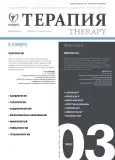Взаимосвязь показателей артериального давления со структурно-функциональным состоянием миокарда у пациентов с хронической болезнью почек 5д стадии
- Авторы: Иевлев Е.Н.1,2, Казакова И.А.1
-
Учреждения:
- ФГБОУ ВО «Ижевская государственная медицинская академия» Минздрава России
- БУЗ УР «Городская клиническая больница № 6» Минздрава Удмуртской Республики
- Выпуск: Том 9, № 3 (2023)
- Страницы: 21-27
- Раздел: ОРИГИНАЛЬНЫЕ ИССЛЕДОВАНИЯ
- URL: https://journal-vniispk.ru/2412-4036/article/view/273984
- DOI: https://doi.org/10.18565/therapy.2023.3.21–27
- ID: 273984
Цитировать
Аннотация
Артериальная гипертензия (АГ) является одним из факторов риска развития гипертрофии левого желудочка (ГЛЖ) у пациентов с хронической болезнью почек (ХБП).
Цель – оценка параметров СМАД у пациентов, получающих лечение программным гемодиализом, в зависимости от структурно-функционального состояния сердца.
Материал и методы. Обследовано 179 пациентов с ХБП 5д стадии (79 мужчин и 100 женщин). Средний возраст участников составил 56,9±12,2 лет, диализный стаж – 5,7±3,5лет. Всем пациентам проводились исследования показателей СМАД и Эхо-КГ.
Результаты. У исследованных пациентов выявлены суточные ритмы АД по типу Non-dipper и Night Peaker по САД (81,6%; p <0,001) и ДАД (73,2%; p <0,001). Установлена корреляция степени ночного снижения САД и ДАД с ММЛЖ (r=-0,45, p <0,01; r=-0,51, p <0,01), ИММЛЖ (r=-0,55, p <0,001; r=-0,53, p <0,01). Скорость пульсовой волны имела связь с междиализной прибавкой веса (r=0,55; p <0,001) и фракцией укорочения средних волокон (r=0,4, p <0,05). У 116 (64,8%) пациентов наблюдалось умеренное увеличение индекса ригидности артерий (p <0,001), который коррелировал с ММЛЖ (r=0,34, p <0,05) и САД (r=0,39, p <0,05). У 135 (75,4%) пациентов с ХБП преобладала парасимпатикотония (p <0,001). Обнаружена связь вегетативного индекса с ММЛЖ (r=-0,51, p <0,001) и ИММЛЖ (r=-0,44, p <0,01).
Заключение. У большинства пациентов с ХБП 5д стадии преобладает парасимпатикотония, имеющая связь с ИММЛЖ. Наблюдается умеренное увеличение индекса ригидности артерий, коррелирующего с междиализной прибавкой веса. Нарушение суточного ритма АД имело связь с ИММЛЖ, уровень ДАД коррелировал с толщиной правого желудочка.
Полный текст
Открыть статью на сайте журналаОб авторах
Евгений Николаевич Иевлев
ФГБОУ ВО «Ижевская государственная медицинская академия» Минздрава России; БУЗ УР «Городская клиническая больница № 6» Минздрава Удмуртской Республики
Автор, ответственный за переписку.
Email: inloja@mail.ru
ORCID iD: 0000-0002-0395-7946
к.м.н., доцент кафедры внутренних болезней с курсами лучевых методов диагностики и лечения, военно-полевой терапии ФГБОУ ВО «Ижевская государственная медицинская академия» Минздрава России, врач-терапевт приемного отделения БУЗ УР «Городская клиническая больница № 6» Минздрава Удмуртской Республики
Россия, Ижевск; ИжевскИрина Александровна Казакова
ФГБОУ ВО «Ижевская государственная медицинская академия» Минздрава России
Email: i.a.kazakova@yandex.ru
ORCID iD: 0000-0001-7815-1536
д.м.н., профессор, зав. кафедрой внутренних болезней с курсами лучевых методов диагностики и лечения, военно-полевой терапии
Россия, ИжевскСписок литературы
- Ashby D., Borman N., Burton J. et al. Renal association clinical practice guideline on haemodialysis. BMC Nephrol. 2019; 20(1): 379. https://dx.doi.org/10.1186/s12882-019-1527-3.
- Vareta G., Georgianos P.I., Vaios V. et al. Prevalence of apparent treatment-resistant hypertension in ESKD patients receiving peritoneal dialysis. Am J Hypertens. 2022; 35(11): 918–22. https://dx.doi.org/10.1093/ajh/hpac086.
- Liu S., Liao Y., Zhu Z. et al. Association between cumulative blood pressure in early adulthood and right ventricular structure and function in middle age: The CARDIA study. Clin Cardiol. 2022; 45(1): 83–90. https://dx.doi.org/10.1002/clc.23763.
- Cai R., Shao L., Zhu Y. et al. Association of central arterial blood pressure and left ventricular hypertrophy in patients with chronic kidney disease. Nephrology (Carlton). 2022; 27(1): 57–65. https://dx.doi.org/10.1111/nep.13967.
- Leibowitz D. Left ventricular hypertrophy and chronic renal insufficiency in the elderly. Cardiorenal Med. 2014; 4(3–4): 168–75. https://dx.doi.org/10.1159/000366455.
- Di Lullo L., Gorini A., Russo D. et al. Left ventricular hypertrophy in chronic kidney disease patients: From pathophysiology to treatment. Cardiorenal Med. 2015; 5(4): 254–66. https://dx.doi.org/10.1159/000435838.
- Sun L., Li Q., Sun Z. et al. Impact of overhydration on left ventricular hypertrophy in patients with chronic kidney disease. Front Nutr. 2022; 9: 761848. https://dx.doi.org/10.3389/fnut.2022.761848.
- Schneider M.P., Scheppach J.B., Raff U. et al. Left ventricular structure in patients with mild-to-moderate CKD – a Magnetic Resonance Imaging Study. Kidney Int Rep. 2018; 4(2): 267–74. https://dx.doi.org/10.1016/j.ekir.2018.10.004.
- Kupferman J.C., Aronson Friedman L., Cox C. et al.; CKiD Study Group. BP control and left ventricular hypertrophy regression in children with CKD. J Am Soc Nephrol. 2014; 25(1): 167–74. https://dx.doi.org/10.1681/ASN.2012121197.
- Fu X., Ren H., Xie J. et al. Association of nighttime masked uncontrolled hypertension with left ventricular hypertrophy and kidney function among patients with chronic kidney disease not receiving dialysis. JAMA Netw Open. 2022; 5(5): e2214460. https://dx.doi.org/10.1001/jamanetworkopen.2022.14460.
- Fujii H., Watanabe S., Kono K. et al. One-year impact of kidney transplantation on cardiac abnormalities and blood pressure in hemodialysis patients. Ther Apher Dial. 2019; 23(6): 529–33. https://dx.doi.org/10.1111/1744-9987.12808.
- Cha R.H., Lee H., Lee J.P. et al. Changes of blood pressure patterns and target organ damage in patients with chronic kidney disease: Results of the APrODiTe-2 study. J Hypertens. 2017; 35(3): 593–601. https://dx.doi.org/10.1097/HJH.0000000000001185.
- Kang E., Lee J., Kim H.J. et al. The association between socioeconomic disparities and left ventricular hypertrophy in chronic kidney disease: results from the KoreaN Cohort Study for Outcomes in Patients With Chronic Kidney Disease (KNOW-CKD). BMC Nephrol. 2018; 19(1): 203. https://dx.doi.org/10.1186/s12882-018-1005-3. Erratum in: BMC Nephrol. 2018; 19(1): 217.
- Che X., Mou S., Zhang W. et al. The impact of non-dipper circadian rhythm of blood pressure on left ventricular hypertrophy in patients with non-dialysis chronic kidney disease. Acta Cardiol. 2017; 72(2): 149–55. https://dx.doi.org/10.1080/00015385.2017.1291133.
- Kim I.Y., Ye B.M., Kim M.J. et al. Association between serum uric acid and left ventricular hypertrophy/left ventricular diastolic dysfunction in patients with chronic kidney disease. PLoS One. 2021; 16(5): e0251333. https://dx.doi.org/10.1371/journal.pone.0251333.
- Chen H., Watnick T., Hong S.N. et al. Left ventricular hypertrophy in a contemporary cohort of autosomal dominant polycystic kidney disease patients. BMC Nephrol. 2019; 20(1): 386. https://dx.doi.org/10.1186/s12882-019-1555-z.
- Schneider M.P., Raff U., Kopp C. et al. Skin sodium concentration correlates with left ventricular hypertrophy in CKD. J Am Soc Nephrol. 2017; 28(6): 1867–76. https://dx.doi.org/10.1681/ASN.2016060662.
- Nitta K., Iimuro S., Imai E. et al. Risk factors for increased left ventricular hypertrophy in patients with chronic kidney disease: Findings from the CKD-JAC study. Clin Exp Nephrol. 2019; 23(1): 85–98. https://dx.doi.org/10.1007/s10157-018-1605-z. Erratum in: Clin Exp Nephrol. 2019; 23(1): 99.
Дополнительные файлы









